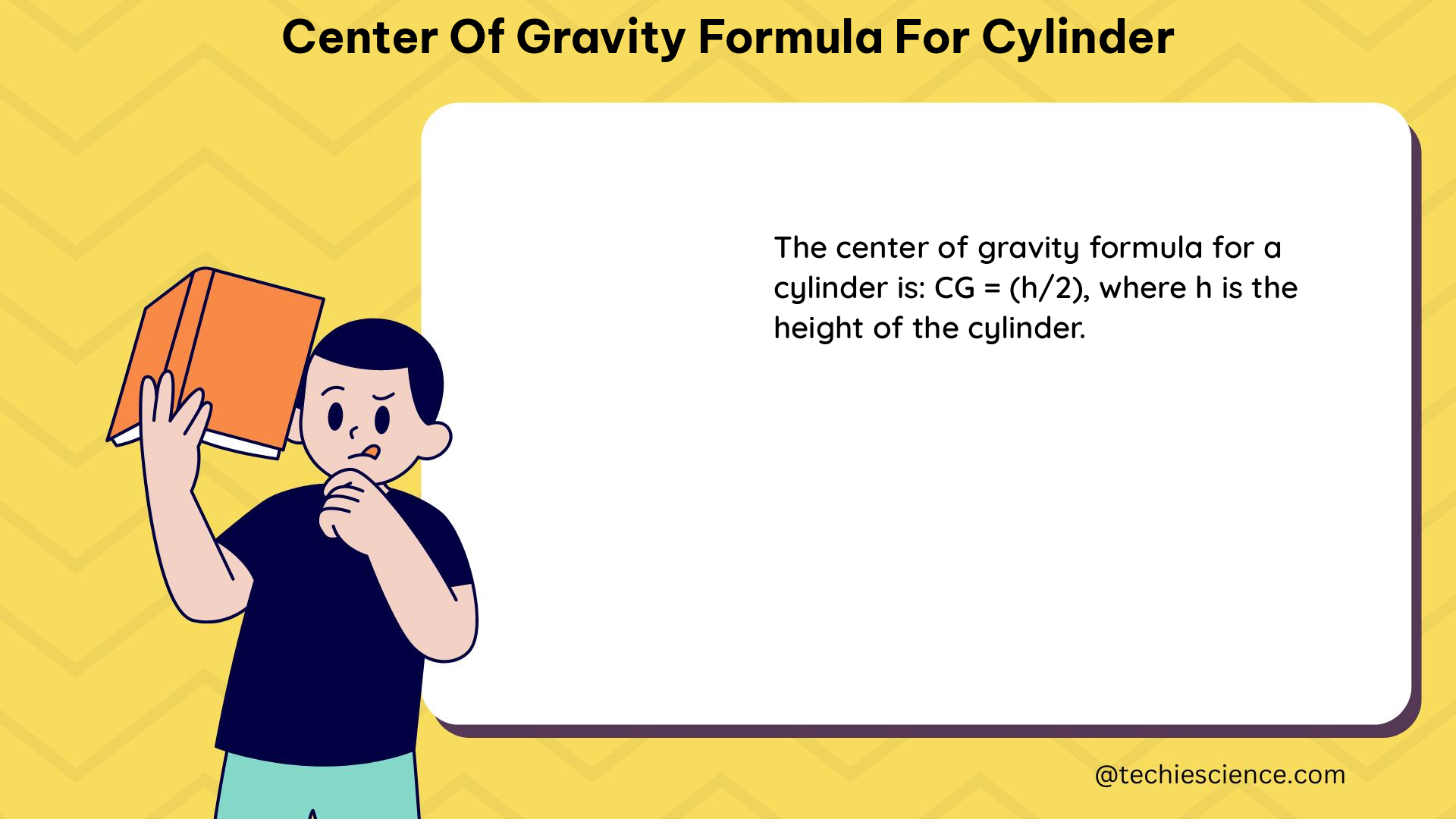The center of gravity (CG) of a cylinder is a crucial concept in physics and engineering, particularly in the study of statics and dynamics. The CG is the point where the weight of the cylinder can be considered to act, making it the point around which the cylinder will balance.
Understanding the Center of Gravity Formula for Cylinders
The formula for calculating the CG of a cylinder is derived from the general definition of the CG for a mass distribution, which is given by the equation:
$\text{CG} = \frac{\int \vec{r} \, \mathrm{d}W}{\int \mathrm{d}W}$
Where:
– $\vec{r}$ is the position vector
– $\mathrm{d}W$ is the differential of weight
– The integrals are to be interpreted as Stieltjes integrals over the entire body
For a cylinder with uniform density, this formula simplifies to:
$\text{CG} = \left(\frac{h}{2}, \frac{r}{2}\right)$
Where:
– $h$ is the height of the cylinder
– $r$ is the radius of the cylinder
Calculating the Center of Gravity for a Combined Cone and Cylinder

In the case of a combined cone and cylinder, the CG can be found by first finding the individual CGs for each shape and then taking moments about the point of intersection. The formula for moments is given by:
$\Sigma D \cdot W$
Where:
– $D$ is the distance from the CG to the point of interest
– $W$ is the weight of the object
The CG of the combined shape is then given by:
$\text{CG} = \frac{\Sigma D \cdot W}{\Sigma W}$
For example, in the case described in [1], the CG of the combined cone and cylinder is found to be at a distance of $\frac{5h}{16}$ from the base of the cone, assuming that the base of the cone coincides with a plane face of the cylinder. This result is derived by taking moments about the point of intersection of the two shapes and solving for the CG.
Applying the Center of Gravity Formula to Complex Shapes and Systems
The formula for calculating the CG can also be applied to more complex shapes and systems, as demonstrated in [4], which provides a step-by-step guide to calculating the CG for a seesaw with two people of different weights.
It is important to note that the formula for the CG assumes a uniform distribution of mass and density. In cases where the mass or density is not uniform, more complex calculations may be required to accurately determine the CG.
Practical Applications of the Center of Gravity Formula
The formula for calculating the CG of a cylinder is a fundamental concept in physics and engineering, with practical applications in a wide range of fields, including:
-
Structural Design: Knowing the CG of a cylinder is crucial in the design of structures, such as silos, tanks, and pressure vessels, to ensure stability and prevent tipping or overturning.
-
Aerospace Engineering: The CG of an aircraft or spacecraft is a critical factor in determining its stability and control characteristics, and must be carefully calculated and maintained within acceptable limits.
-
Robotics and Automation: The CG of a robotic manipulator or other automated system is essential for ensuring smooth and stable operation, as well as for optimizing the system’s energy efficiency and load-bearing capabilities.
-
Biomechanics: The CG of the human body and its various segments is an important consideration in the study of human movement and the design of prosthetic devices and assistive technologies.
-
Transportation: The CG of vehicles, such as cars, trucks, and trains, is a crucial factor in determining their handling characteristics, stability, and safety.
By understanding the center of gravity formula for cylinders and its applications, engineers and physicists can better predict and analyze the behavior of complex systems and structures, leading to more efficient and reliable designs.
References:
- Find the center of gravity of a combined cone and cylinder
- Accurately Measure Center of Gravity – Raptor Scientific
- What is the gravity inside a cylinder? – Physics Stack Exchange
- 5 Ways to Calculate Center of Gravity – wikiHow
- How can we quantify gravity within and outside a non-rotating cylinder in outer space?

The lambdageeks.com Core SME Team is a group of experienced subject matter experts from diverse scientific and technical fields including Physics, Chemistry, Technology,Electronics & Electrical Engineering, Automotive, Mechanical Engineering. Our team collaborates to create high-quality, well-researched articles on a wide range of science and technology topics for the lambdageeks.com website.
All Our Senior SME are having more than 7 Years of experience in the respective fields . They are either Working Industry Professionals or assocaited With different Universities. Refer Our Authors Page to get to know About our Core SMEs.